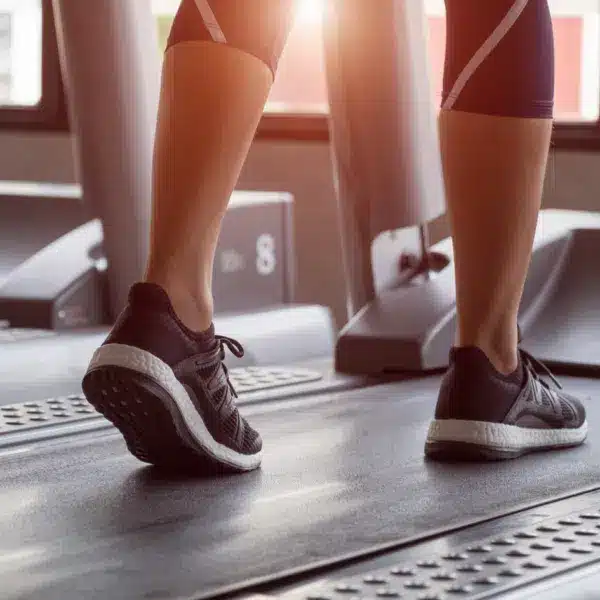
If you’ve been dedicated to shedding excess fat from your waistline, thighs, and hips, you’re part of a unique group with this goal.
A frequent inquiry among fitness enthusiasts pertains to the quickest and most effective approach for achieving this objective, and the consistent answer remains: Cardiovascular exercise is a fundamental component for fat burning.
Numerous beliefs have gained traction within both exercise aficionados and professionals regarding the optimal form of cardio for fat loss, the necessary duration of exercise to stimulate fat burning, and related topics.
This article delves into the scientific underpinning of fat burning through cardiovascular training and offers practical insights to optimize your fat-burning capabilities.
Understanding Cardiovascular Exercise
Cardiovascular exercise, commonly referred to as cardio, targets the cardiovascular system, encompassing the heart, blood vessels, and lungs.
This entails engaging in continuous movements that elevate heart rate and enhance oxygen consumption, thereby fostering cardiovascular fitness and endurance.
Over time, this enhances the efficiency of the heart and lungs, facilitating improved oxygen and nutrient delivery to muscles during physical activity.
Examples of cardiovascular exercises encompass jogging, cycling, swimming, brisk walking, as well as utilizing cardiovascular training equipment like treadmills, ellipticals, or rowing machines.
Energy Utilization During Cardio
During exercise, energy is predominantly sourced from carbohydrates or fat. The body perpetually utilizes both carbohydrates and fat as energy sources, albeit in varying proportions contingent upon the activity and individual fitness level.
Intense exercise primarily draws upon carbohydrates as the energy source, while lower-intensity activities lean more towards fat utilization. Given the ample fat reserves, low-intensity efforts can be sustained over extended periods.
Athletes tend to shift to fat burning earlier than less conditioned individuals. Nevertheless, for the purpose of weight loss, the key factor is overall energy expenditure (calories).
Extended, well-executed high-intensity workouts yield greater calorie burning compared to abbreviated, less demanding sessions. Thus, striving for regular, moderately to highly intense workouts throughout the week promotes calorie expenditure, regardless of whether fat or carbs serve as the energy source.
Varieties of Cardiovascular Training for Fat Loss
Three categories of cardiovascular training exist: low-intensity steady state (LISS), moderate-intensity steady state (MISS), and high-intensity interval training (HIIT).
Low-Intensity Steady State (LISS)
LISS entails maintaining a consistent, gentle exertion level during workouts, lasting around 30 to 60 minutes.
Your heart rate remains relatively stable within the aerobic zone. You should be able to have a conversation with little difficulty
LISS enables fat burning without excessive strain on the body. Examples include leisurely jogging, walking, or cycling at a moderate pace.
Consider the following treadmill routine:
-
- Start with a 5-minute gradual warm-up walk.
-
- Increase speed (slightly slower than brisk walking) and elevate the incline (level 5). Maintain this pace for 30-60 minutes.
-
- You can hold on to the handles if you feel unstable
Moderate-Intensity Steady State (MISS)
MISS strikes a balance between LISS and HIIT, involving sustained moderate effort and a consistent pace.
Heart rate increases compared to LISS, yet remains below the intensity of high-intensity workouts.
Examples encompass brisk walking, jogging at a moderate pace, swimming laps, and cycling at a somewhat faster speed.
Try this treadmill plan:
-
- Begin with 5 minutes of light stretches followed by a slow 5-minute warm-up walk.
-
- Gradually transition into a moderate jogging pace.
-
- Aim for a 25-40 minute jog at the same intensity.
-
- Conclude by lowering the pace for a 5-minute cooldown walk.
High-Intensity Interval Training (HIIT)
HIIT alternates brief, intense exercise bursts with active recovery or rest periods.
The workout challenges the cardiovascular system intensely, resulting in a shorter duration compared to other cardio types.
Sprinting, maximum-effort cycling, and vigorous bodyweight exercises (e.g., burpees) typify HIIT exercises.
For a treadmill-based routine:
-
- Extend the warm-up to 10 minutes with light stretches and walking.
-
- Ramp up to a 90-95% max speed sprint.
-
- Sprint for 20 seconds followed by a 40-second slow-paced walk
-
- Maintain this pattern for 10-20 minutes.
Optimal Cardio Intensity for Weight Loss
All three categories—LISS, MISS, and HIIT—are effective for fat burning. The choice hinges on individual fitness level and available time.
LISS
Since LISS sessions extend over a prolonged duration, the body predominantly taps into fat stores as its primary energy source, contributing to the perception that these exercises are linked to fat loss.
For beginners, LISS serves as an ideal starting point, offering not only the advantage of fat burning but also gradual enhancement of endurance.
Another rationale for favoring LISS pertains to fatigue resulting from previous workouts.
There are two reasons for this:
-
- LISS places reduced strain on the body, allowing for safe execution and added calorie expenditure without the risk of injury.
-
- The augmented blood circulation prompted by LISS facilitates greater nutrient and oxygen delivery to fatigued muscles, thereby accelerating their recovery.
MISS
Sitting between the realms of LISS and HIIT, MISS strikes a harmonious equilibrium between workout length and intensity, rendering it a favored selection for the majority.
Given its heightened intensity in comparison to LISS, it facilitates increased calorie consumption within the same timeframe while further cultivating endurance.
It’s worth noting that for MISS to yield results, sustaining a moderate pace for a minimum of 25 minutes is recommended. If this duration proves challenging, it might be prudent to persist with LISS until your fitness levels advance sufficiently to embrace this form of cardiovascular.
HIIT
If your schedule is tight yet you’re aiming for an exceptional workout, HIIT emerges as the optimal selection.
HIIT is meticulously crafted to push your body to its utmost capabilities within a condensed timeframe.
Moreover, certain studies have indicated that following HIIT sessions, the body sustains heightened calorie expenditure for an extended period.
Nevertheless, maintaining elevated intensity, even briefly, proves demanding for many and can potentially lead to injury if muscular strength is inadequate.
I would suggest considering HIIT after a few months of dedicated gym training, allowing your body to attain the requisite readiness.
Maximizing Fat Burning Potential
While cardiovascular training is pivotal for fat loss, it shouldn’t stand alone. Other factors play a crucial role.
Strength Training
During the process of weight loss, it’s not uncommon to experience a reduction in both fat and muscle mass. Engaging in strength training serves to safeguard your lean muscle tissue, ensuring that the weight loss primarily targets fat rather than muscle.
This emphasis on preserving lean muscle holds significance due to its positive impact on your overall resting metabolic rate. A substantial loss of muscle mass could potentially impede your ability to effectively burn calories throughout the entirety of the day.
Moreover, an increased proportion of lean muscle mass enhances your body’s efficiency in utilizing fat as a source of energy. Consequently, engaging in cardio activities may lead to a heightened proportion of fat burning when you possess greater muscle mass compared to a scenario with reduced muscle mass.
Balanced Meals
The foremost aspect of weight loss revolves around achieving a calorie deficit, signifying that your daily caloric intake should be lower than your expenditure.
Determine your daily energy requirements and target a moderate calorie deficit ranging from 200 to 500 calories per day.
Strive to reduce your consumption of processed foods and replace them with whole foods, as the latter tend to possess fewer calories while being more nutrient-dense.
The optimal quantity of macronutrients, including healthy fats, hinges on factors such as your weight, gender, age, and daily activity level. As a result, a definite answer cannot be provided.
Fortunately, valuable free online tools are at your disposal; an example is myfitnesspal. Employing this tool allows you to compute your total daily calorie needs. Simply log your food intake as you consume it—it’s a straightforward process.
Hydration
Following a cardio session, fluid loss through perspiration occurs, underscoring the necessity to replenish these fluids. Several reasons validate this practice.
When you maintain proper hydration, your metabolic processes, inclusive of fat metabolism, operate with enhanced efficiency. Consequently, your body’s capacity to burn stored fat improves, facilitating smoother weight loss.
Furthermore, sustaining adequate hydration accelerates muscle recovery. Sufficient water intake maintains optimal blood circulation, facilitating the swift delivery of indispensable nutrients and oxygen to your muscles.
This effective nutrient conveyance proves pivotal for muscle reparation, supplying the essential foundational elements required to rebuild compromised muscle tissue.
Spot Training Myth
Regrettably, the concept of ‘spot training’ is unfounded.
No enchanting ‘fat wand’ exists to dictate the specific regions from which fatty tissues will diminish within your body.
Genetics wield substantial influence over your body’s response to diligent weight loss efforts. Your physique undergoes a comprehensive transformation, acting as a unified entity rather than targeting isolated body parts.
Nevertheless, you possess the ability to steer the fortification, toning, and enlargement of distinct muscle groups through targeted strength training.
Reshape and fortify muscles such as biceps, triceps, quadriceps, and more by engaging in consistent and demanding exercises utilizing weights, resistance bands, exercise balls, or even your body weight.
Conclusion
Sustain your motivation by diversifying your exercise regimen to ward off monotony and establish specific targets for shedding pounds or inches.
While each person possesses a unique ‘fat burning zone,’ prioritize calorie expenditure if your aim is weight loss. Simplify matters by consistently challenging yourself and extending your boundaries, rather than fixating on the precise anatomical locations of fat loss.
As you progress on your fitness journey, consider varying the intensity of your cardio workouts to introduce novel challenges to your body.
It’s important to note that solely relying on cardio won’t yield significant outcomes. Incorporating strength training, maintaining a well-rounded diet, and ensuring optimal hydration are essential components for comprehensive success.
Thank you for your readership! Wishing you a healthy and vibrant week ahead! you can contact us for more updates regarding Cardiovascular Training



